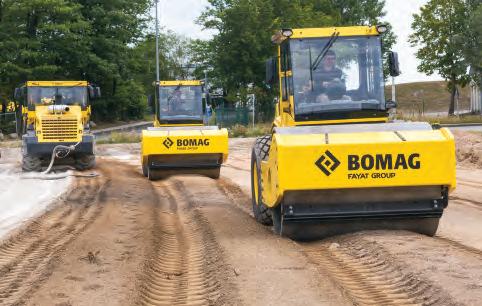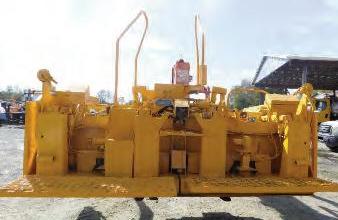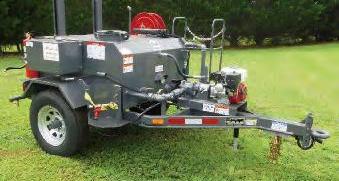
14 minute read
MINNICH MANUFACTURING RECEIVES GOMACO SUPPLIER OF THE YEAR HONOR
ACTION SOIL COMP



The Award Goes To... Minnich Manufacturing Receives First GOMACO Supplier of the Year Honor

The award was presented to Minnich for its dedicated effort and continued partnership toward GOMACO’s business success for 2020 and the years ahead. Minnich Manufacturing is the first-ever recipient of the award.
Minnich Manufacturing, a manufacturer of concrete dowel pin drills, concrete vibrators and vibrator monitoring systems, has been recognized as GOMACO Corporation’s 2020 Supplier of the Year.
The award was presented to Minnich for its dedicated effort and continued partnership toward GOMACO’s business success for 2020 and the years ahead. Minnich Manufacturing is the firstever recipient of the award.
Minnich and GOMACO have worked together in the concrete paving industry for many decades. Minnich products are used on several of GOMACO’s equipment, including the HV-2PE hydraulic internal paving vibrator, the Auto Vibe CC vibrator monitoring system, and most recently, the Stinger electric flex shaft vibrator.
GOMACO, a worldwide leader in concrete construction equipment with headquarters in Ida Grove, Iowa, offers products through a global distributor network for local sales, parts and service expertise. GOMACO has a full line of concrete paving equipment to meet today’s concrete challenges.
“At Minnich, we pride ourselves on service and developing innovative products that
solve contractors’ problems,” said Todd Jurjevic, president/chief sales officer (CSO) of Minnich Manufacturing. “Receiving this award from GOMACO is an honor and the “At Minnich, we pride ourselves on service and developing innovative products that solve contractors’ problems.”
Todd Jurjevic
Minnich Manufacturing reason our team continues to believe in making service a priority.” Minnich Manufacturing is committed to offering support and concrete products to maximize jobsite productivity. For more information about Minnich Manufacturing, visit www.minnichmfg.com.

Products shown with optional equipment.
ULDINMA
ving aP g Products... MASTERS T! AT! S OF THE MA
Contact your dealership today to see the newly redesigned NMAULDIN
1860 Commercial Paver
.4aMauldin.com.For more information visit us at www

Golden Equipment Company
www.goldenequipment.com
Closner Equipment
www.closner.com

866-430-7539
www.jfwequipment.com sales@jfwequipment.com
Serving the Asphalt Industry for 30 Years
2003 Rosco Maximizer II distributor, 1750 gallons, EZ-2S computer w/1 ft cutoffs, diesel heat, 12 ft spray bar, 2003 Freightliner, Cummins dsl eng, auto trans $52,000


New Marathon LD600PT asphalt distributor, 585 gallons, Honda 11 hp electric start gas eng, 80 GPM hyd. pumping system, propane heat, auto temp control, fully insulated tank, 8 ft spray bar, operator’s platform, 5 ft spray wand & 50 ft hose, flushing system, recovery tank, electric brakes & electric breakaway - $37,200

2001 Omni IIIA screed, 10-18 ½ ft diesel heated screed, power crown & slope - $3800

2019 Volvo DD35B double drum 54” vibratory roller, Kubota 4 cyl diesel engine, double drum drive, water system, 4 tons - $34,000 New Marathon TPS250T tack distributor, Honda gas eng, 18GPM pump, 250 gal, 5 ft spray wand w/50 ft hose, 6 ft spray bar, operator’s platform, propane burners, flushing system, electric brakes - $13,600



New Marathon TPS115S tack distributor, Honda gas eng, 10GPM pump, 115 gallons, 5 ft spray wand w/50ft hose, hose reel, propane heat, flushing system - $8795

2012 Broce RJT350 broom, heat & a/c, John Deere turbo diesel engine, 8 ft broom, water system, all new tires - $31,000

Steep Drop-Offs Make for Challenging Construction
CASCADE from page 23
of Cascade Springs Road and 6.8 mi. of Cascade Scenic Drive, beginning at State Route 92 (Alpine Scenic Loop Road) and ending to the east at the entrance to Wasatch Mountain State Park, approximately 4 mi. outside of Heber City, Utah.
“The unpaved section of the road was the most challenging, but also was a place where we could improve drivability and safety the most,” said Chris Robbins, project manager of DSB Construction. “Using the 3D modeling showed us the best place to realign the roadway. In some places, we realigned it 20 feet from its old location. This helped us to move forward efficiently and also helped us track the quantities of materials we would have to use.”
Building the new road involved much more than just paving. “We rebuilt the slopes in four different spots,” said Robbins. “Some spots had dangerous drop-offs, which the joint venture team helped fix by adding shoulders as well as safety features like guard rails. In other areas, the team had to remove part of the cliff, so the paving equipment could manage the curves of the pavement. Building the new road also required blasting rock to remove it from where the newly aligned road was supposed to lead.”
A subcontractor anchored chain mesh on certain cliff faces to catch any rocks dislodged in the future that could endanger drivers.
Creating Two-Lane Roadway
The first phase of the project, the 5.3 mi. of Cascade Springs Road, required workers to transform the path from a beat up, narrow, dirt road to a safe two-lane pavement.
During the second phase, the Geneva Rock team pulverized the 6.8 mi. of Scenic Drive and used the crushed fragments of the old road to form a strong aggregate base.
In total, both section of new road required 30,000 tons of an aggregate base and 30,000 tons of fresh asphalt on top. Workers paved the new road with two lifts of 1.5 in. of asphalt for a total of 3 in. of asphalt. The asphalt mix was a standard Federal Highways composition, using limestone as the aggregate.
The unusual nature of the project forced special safety precautions. “Because the road was so narrow with steep drop-offs, we gave our truck drivers hand-held walkie-talkies and numbered the curves,” said Mike Summers, project manager of Geneva Rock. “This enabled the drivers to tell the other drivers which curve they were on to avoid collisions. Our safety manager conducted regular site inspections with safety meetings held on-site to address concerns.”
The two-year project began with earthwork first and included installing culverts to divert the rain and snow away from the roadway, again increasing safety for the drivers. Truckers hauled the asphalt from Geneva Rock’s plant located in Draper.
The completed project drew rave reviews. Dallin Koecher, executive director of Heber Valley Tourism, Economic Development, said, “Now that Cascade Springs Road has been finished, it provides effortless access to Heber Valley. In the past, people sometimes didn’t travel it if their vehicle didn’t have high ground clearance. Many people didn’t
want to drive on a dirt road. Because of that, they would miss seeing some of the beautiful spots in this area. My family has taken this new road many times and we enjoy the smooth travel. The Wasatch Mountain State Park and Cascade Springs areas are beautiful. Now they are easily accessible to many more people.”
Robbins looked back with satisfaction at the two-year project completed in spring 2021.
“Driving the new road for the first time was amazing,” he said. “The road is exponentially safer than it was before. The job was one of the most challenging and gratifying projects I have done in my 25-year career in construction.”
The major subcontractors for the job included QC Testing for quality control; Rock Supremacy for anchor wire mesh; B Jackson Construction for pulverizing; Diamond Tree for tree removal; B&K for guard rail; Express Environmental for erosion control; and Overman Concrete for concrete. CEG


SUSTAINABILITY from page 1
ation. That goes for contractors as well.
“To remain competitive in the construction market, owners must adapt,” said Lester, in an AGC Constructor article on a sustainable approach to construction.
Rajeev Mittal, a managing director of software developer Autodesk, has a similar perspective. In his mind, the pandemic allowed sustainability to gain “some unexpected traction.”
Mittal wrote for LinkedIn that broken supply chains proved how vital localization was in achieving business continuity.
“With many raw materials becoming impossible to source, indigenous businesses accelerated innovation in local, sustainable alternatives,” he explained.
“The construction sector also witnessed a surge in the interest for 3D printing, generative design and prefabrication.”
All considered to be more sustainable options, he added. “Climate action is everyone’s responsibility.”
Lester maintained that with more frequent uneven weather patterns and increased temperatures due to climate change, builders are approaching new projects with climate resilience in mind.
“As engineering improves, construction companies should continue staying up to date on methods to build for the long-term that will withstand extreme weather conditions,” he stressed.
“This will reduce the number of repairs needed on a project and, in turn, the fuel consumption and waste that comes with these fixes.”
He suggests using high-quality products specifically tailored for each project to minimize emissions and decrease carbon footprint on a job site.
“When an asphalt job is done well, it will decrease the need for larger, more expensive repairs in the future,” he explained.
“With this approach, excess emissions from unneeded jobs are virtually eliminated, not to mention client satisfaction is improved.”
Green Approach
Lester’s first suggestion is to prioritize the sustainable materials allocated for a project. For example, choose high-quality asphalt, additives, crack fillers and pavement sealers.
Avoid going straight to materials that may be cheaper but are worse for the environment. Better materials “not only protects employees, it is better for the environment,” he added.
Talk to your suppliers. “There are many ways to obtain greener materials as well. Start by speaking directly to your suppliers to figure out how and from where they’re sourcing their products,” suggested Lester.
“If you’re ordering in large quantities or know other businesses who buy products from the same supplier, you may be able to convince your supplier to work with more sustainable partners.”
Working with local suppliers also can reduce emissions as a result of shorter transports to your job site.
In a webinar, Charlie Cichetti, co-founder and CEO of Sustainable Investment Group, gave a list of 10 steps companies can take to “green up” construction sites. Obtaining green materials was high on the list.
“This one may seem like an obvious point but using green materials for both permanent and temporary structures at a jobsite is necessary for creating a green building,” he said.
He urged site owners and contractors to “go above and beyond on finding cost-effective yet rapidly renewable materials.”
Choose recycled materials over items without recycled content, even focus on green materials for temporary materials used during construction, suggested Cichetti.
How materials are used matters. Cichetti commented that using prefabricated or preassembled pieces in a project can be environmentally friendly.
Many times, a project owner or contractor will bring in a surplus of materials to ensure crews have enough supply to complete the project.
“Using prefabricated materials can reduce this waste because the piece is delivered whole, preventing the need for extra resources,” he noted.
Preassembled pieces can also reduce carbon emissions in addition to being more cost-efficient, since they require a single shipment only.
But potentially most important, noted Cichetti: Using these prefabricated materials instead of assembling pieces onsite can reduce the risk of injury and ensure crew members’ safety.
Lester believes construction managers must also ensure their crews are knowledgeable about working sustainably.
He suggests recommending ridesharing to staff to reduce transmission emissions.
“You could also help organize a ridesharing system for your employees to reduce transportation carbon emissions while getting to and from a work site.”
In the same vein, Cichetti pointed to preferred parking for electric vehicles and HOV lanes for carpooling. “Why not use these same incentives for employees traveling to a job site?” posed Cichetti.
“Providing people who participate in these alternative transportation methods with closer and more accessible parking spaces can help to reduce carbon emissions by cutting down on transportation-related emissions on the job site.”
Lester suggests making your machinery a friend of the environment by using it wisely.
He noted that instead of allowing equipment to run nonstop to reduce downtime between tasks, green construction sites reduce equipment usage time to save energy.
Clean up your site.
Lester also noted that job sites by nature can produce a large build up of waste. “One way to ensure the project is more environmentally friendly is to dispose of waste properly.”
Rethink what you’re hauling away from the site. “Many materials that might be considered waste can actually be recycled or reused in future projects,” he pointed out.
Recycling and reusing can actually save
your business money and time on a future project.
“Consulting with a waste removal service can also aid in ensuring your site is removing waste in the most efficient way possible,” he added.
Cichetti believes tracking job site waste electronically is vital for maintaining a green construction site and diverting some of this waste.
“Completing a waste audit can help to show where waste is going and how waste management can be improved.”

To obtain greener construction materials, start by speaking directly to your suppliers to figure out how and from where they’re sourcing their products.
Universal Rewards
Cichetti sustainability webinar participants heard him talk about greening-up in terms of the global LEED green building rating system, but his ideas and suggestions could be beneficial for any job site.
He suggests performing an audit of utility usage on the construction site. He considers it vital for knowing where major cost sinks and carbon sources are on site.
“Additionally, logging information about fuel and gas is important as it has a larger footprint than other utilities on a job site.”
He believes that following jobsite best practices can help to green up any construction site. As an example, Cichetti pointed out how LED temporary lighting can not only reduce the amount of electricity used on a project, but can be transferred from project to project to reduce costs.
“Furthermore, putting timers or sensors on the lights can increase these cost and sustainability benefits,” he added.
Other best practices for sustainability can include just providing reusable water bottles to the crew or team; having compostable containers/plates/utensils as well as a compost bin; creating and growing a garden for projects with long timelines; and improving signage for dumpsters and sorting materials.
“These are all examples of simple and cost-effective changes that a green team can implement to greatly reduce the carbon footprint of a construction site,” said Cichetti.
Virtual meetings came in with the coronavirus pandemic and stayed. So many people working remotely and communicating via video conference has actually helped reduce carbon emissions by cutting down on travel, he observed.
“Of course, some site visits will be essential, but for those that aren’t, virtual meetings can help to reduce carbon emissions as well as cut down on time while still sharing information.”
He pointed out that video conferencing can even be used to look at equipment or data as a team without everyone having to travel to the project site.
Number one on Cichetti’s list of steps companies can take to “green up” is learning about embodied carbon.
Embodied carbon is the sum impact of all greenhouse gas emissions of a particular material throughout its life cycle. It is responsible for 11 percent of global greenhouse gas emissions.
Cichetti believes that between now and 2050, embodied carbon is projected to account for almost 50 percent of total new construction emissions.
He also believes by that 2035 we will see a shift of emphasis onto embodied carbon instead of operating carbon, which is focused on efficiency.
For example, concrete uses the highest amount of embodied carbon, followed by steel, then ceramics, he said. “Therefore, replacing concrete with something like fly ash can cut down on embodied carbon on a job site.”
Lester, of Dura-Seal, believes that in the long-term, sustainability practices will continue changing due to regulation and innovation.
“But construction companies that adapt early on will attract customers who want to work with partners who have a proven track record,” he said.
“By kickstarting your company’s sustainable construction methods in 2021, you’ll gain a competitive edge for years to come.”

Four Seasons Equipment
8111 Mills Rd. Houston, TX 77064
800-234-5007
Dallas, TX
866-270-1700
www.fourseasons-equip.com
Porter Group USA
13013 Temescal Canyon Rd. Corona, CA 92883
951-674-9999
9879 San Fernando Rd. Pacoima, CA 91331
818-834-0102
www.portergroupusa.com
Orion Equipment
18060 Des Moines Memorial Drive Seattle, WA 98148 800-280-8124 www.orion-equip.com






